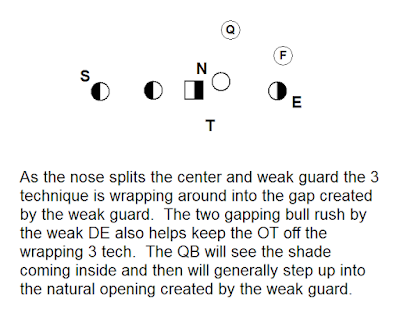I've gotten quite a few questions since first posting about the Two Gap One Gap (TGOG) defensive scheme. I'm going to answer what seem to be some unanimous questions about the technique to try and further clear up some of the confusion. I myself have even been confused at times about certain merits of the scheme, but have gotten clarifications over the past year and aim to shed light on these questions than many readers have been asking.
The Two Gap Defensive Tackle Vs. the Double Team
When I first learned about the technique, it was mainly being used to allow linebackers (LB's) to walk out of the box, and be better adapted to fitting against one back run games from the spread offense. Most of the en-vogue running styles back then were pure zone in nature, or gap only to the point of having the quarterback (QB) being led by the offset running back (think QB Iso or QB Power). As time has gone on, and more and more teams are gap run oriented, the need to address the play of the two-gapping defensive tackle (DT) in the scheme needed to be addressed. Quite simply, when this player feels a double team, he is to sit and maintain gap integrity, looking to the hold the double team and keep the scrape player from coming off and blocking the LB. Even though, as we know from previous posts, this player is essentially "teeing off" on the guard in front of him, once he feels the outside pressure from the down blocking tackle, he must fight pressure with pressure to avoid being washed down. By doing this, it allows the LB's more time to fit vs. these spread gap scheme runs. If he were to continue on his normal path, fighting into the A gap, this would create a large running lane, and also give the scraping offensive tackle (OT) a free shot at the LB.
One note, against gap schemes this past season we were about 50-50 in running TGOG. To be quite honest, it fares better vs. zone, but does have it's place against gap style run games. The idea here, is not to "base" out of the scheme, but use the scheme as a means to adapt to, and attack what is being thrown your way by your opponent. When we break down our opponent, we look at the merits of traditional block down, step down (BDSD) vs. TGOG to see what will give our opponents more trouble. We have even gone so far as having just a two-gapping defensive end (DE) against some teams. These are just subtle adaptations to the scheme to better allow you to prepare for what your opponent is trying to accomplish with their offensive attack.
Pass Rush Issues
One of the largest issues with TGOG is that it reduces your ability to rush the passer from both sides. While true in one respect, there are some teams that have very interesting "twist" built into their scheme that allows them to still attack the passing game with some aggressiveness. To first understand the scheme, we must see its limitations when it comes to rushing the passer.
The "elephant in the room", so to speak, is the fact that the two-gapping DE, is largely ineffective in rushing the passer. Because this player, has to keep contain against a pass set by the OT, he must work from a tight shade, bull rush mentality to now one of containing a QB. This can be difficult to do from a tight shade (remember, the two-gappers align tighter to their offensive lineman than the one-gappers do). By bull rushing, a generally larger opponent, lends itself very little room for the DE to execute an escape move by the time the ball has gotten out of the hands of the QB.
The adaptation, or twist (literally) comes into play is between the DT's. The DT's, if given a pass set, will attempt to rush to the opposite side of the QB. The scheme is really THAT simple. Where the coaching comes into play is against either a true pass set, or a hard set, such as slide protection.
Against a true pass set, or big-on-big (BOB) protection, the two gapping DT, will rush hard inside and attempt to work to the opposite side of the QB. This technique almost always results in the guard having to quickly collapse down to the inside to cut off the inside rush lane. The one-gapper, usually in a shade, will be double team from the snap, and will not get as much depth as the two gapper, which creates a perfectly timed stunt, as the one-gapper crosses the center's face has he rushes to the opposite side of the QB. The QB, will generally look to step up into the opening created by two factors. The first is the two-gapping DT that crossed the guard's face and the fact that the DE to the two gapping DT's side is generally a one gapper (unless there was a TE). This opening is where the shade will fit in his pass rush and almost always will yield a sack or some pressure. The guard, blocking the two-gapper will have a tough time coming off and blocking the shade, because of the manner in which the two gapper attacks the guard. Remember, the two gapper is playing king of the boards (KOB) here, so he bull rushes the guard, sees pass and then crosses the guard's face. I don't know about where you coach, but we don't see too many high school guards that can handle that and still switch off to take the shade. The center, if he chases, most often gets caught up with the guard assigned to block the two gapper and the two gapper. The result is the shade almost always coming Scott-free.
Against the hard set, the two gapper simply has to know what is the center doing. If the center has gone away from him, then the two gapper will use the guard's push to slam himself into the near hip of the center, and from there will look to work vertically into the backfield. The guard's initial push will aid the two gapper in getting to the opposite side of the QB from the snap. If the hard set comes from the center, then the two gapper will simply chip across the face of the center and then work vertical to attack the opposite side of the QB. The shade does the exact same thing! If the center hard sets on him, he will come flat across the face of the center and work to the opposite side of the QB. If he gets a hard set to him from the guard, he presses into the near hip of the center, then attacks vertically to the opposite side of the QB.
The nice thing about the technique is when we use it, we generally set the three technique away from the offset running back (RB) in the gun. If teams choose to slide protect against us, then what they will be getting is the shade, slamming into the center, and then pushing vertically to the strong side of the QB, while the two gapping three technique will loop around to weak side of the QB. The quicker the DT's the better this "twist" works, but it can be quite effective.
The other nice thing about teaching the technique this way is that you can still line up in one's, two's or three's and the DT's are doing the same thing no matter if they are a two gapper or a one gapper. This means there isn't any new teaching based on alignment. Multiplicity through simplicity!
Some offensive schemes that do limit the effectiveness of TGOG in the pass rush game are those offensives that use 11 and 12 personnel groupings. The nine technique, is generally a two gapper, so his ability to rush the passer is greatly reduced. In the past, there have been some calls, where if the LB remains in the box, the DE will play traditional BDSD rules and can be a bit more aggressive against the pass. However, if this LB has to leave the box, this DE will then become a two gapper. Again, the idea behind all of this is trying to figure out exactly what you need to stop to defeat your opponent. If you are facing a team with a good QB, that passes over half the time, TGOG might not be what you want to use. If you face an 11 or 12 personnel team that runs the ball 75 percent of the time, you might want to use TGOG. Good film study and game planning can usually help answer these questions.
The Rush DE, to Box or Not to Box
In the early years of using the scheme, there was some debate on the technique of the rush DE, or the one-gapping DE. Early on some coaches attempted to have this player rush, but then "duck under" and wrong arm any pullers, or kick out blocks. Unfortunately this has proven just too costly in the grand scheme of things. Where I work at now, the one gapping DE always boxes. There will even be times when we play this player in two-point stance so he can better read and react to the blocks he's seeing, but even so, we still have him just box. By keeping him doing just one thing, we are able to keep it simple, and allow our guys to play faster. In recent years with advent of Power Read and Inverted Veer and other edge plays, coupled with run-pass options (RPO's), the one gapping DE has had to even become the force player. It is much easier to be the force player when you know, that you only have one way in which you react to certain blocks. Basically by boxing, we've taken the "if this then that" part of the equation away from the player.
Basing Out of TGOG
TGOG For The Odd Front
 |
| I really don't know?! |
Hopefully this post will answer some of your questions on the matter. I have had the privilege this past season to work with one of the true innovators of the scheme and really get to see it's nuances. Hopefully there will be more to come from this upcoming season!
Duece













